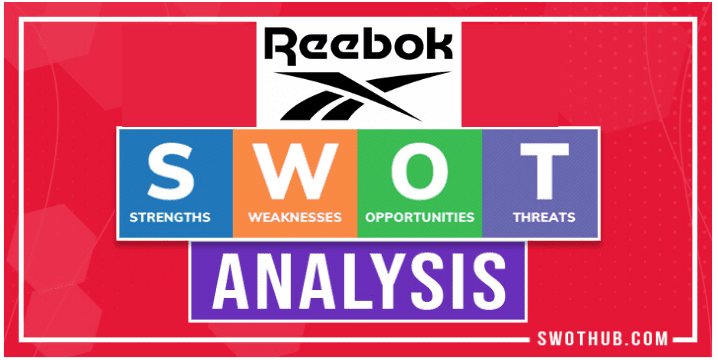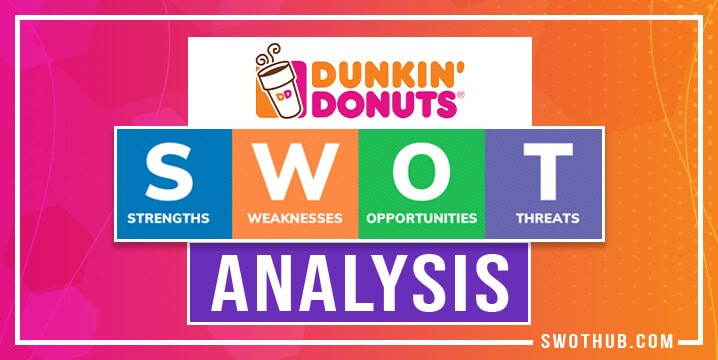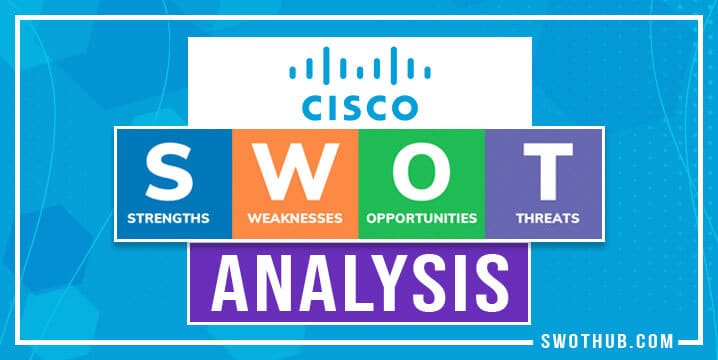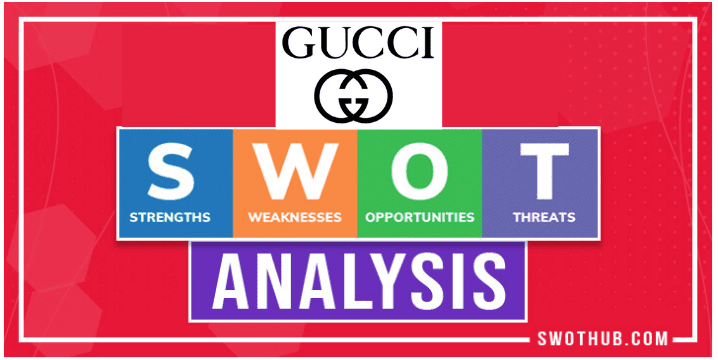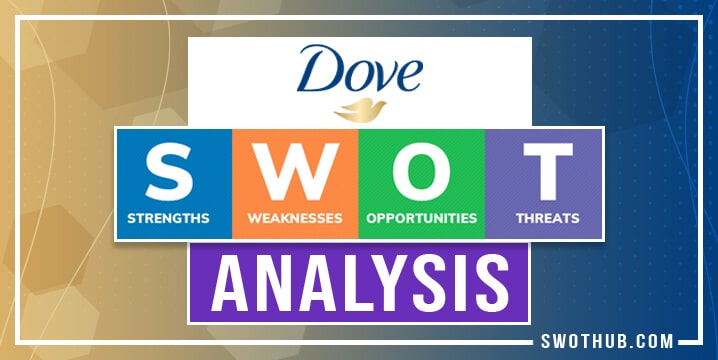The athletic sportswear retail industry has been a competitive space for decades. In a Reebok SWOT analysis, we take a look at how this British-American company started with humble beginnings to then skyrocketed in the market in athletic shoes in the 1980s. Unfortunately, they have had declining sales and market share losses to fierce competitors like Nike and Adidas. In a SWOT analysis of Reebok, we look at Reebok’s strengths, weaknesses, opportunities, and threats.
Table of Contents
Reebok History
In 1895, Joseph William Foster established Reebok, a British-American manufacturer of footwear and clothing, in Bolton, England. At first, the business was known as J.W. Foster and Sons, and it produced spiked running shoes.
Joe and Jeff Foster, two of Foster’s grandsons, changed the company’s name to Reebok in 1958, after an African gazelle. The brothers thought their athletic shoes were reflected in their desire for a name that sounded quick and nimble.
Tennis shoes and aerobic footwear were added to the Reebok product line in the 1970s, just before the fitness craze of the 1980s made them popular. Bjorn Borg, a tennis player, and Shaquille O’Neal, a basketball player, are just two of the well-known athletes with whom Reebok signed endorsement deals to cash in on this trend.
In a Reebok SWOT analysis, Reebok experienced increased competition in the 1990s from rivals like Nike and Adidas. To compete, the business changed its emphasis to lifestyle footwear and apparel, securing endorsement deals with hip-hop stars like 50 Cent and Jay-Z.
Adidas bought Reebok in 2005, resulting in the world’s second-largest manufacturer of athletic footwear and apparel. Reebok still makes athletic and casual clothing and footwear today with an emphasis on social responsibility and sustainability.
Reebok SWOT Analysis At-A-Glance
| Company | Reebok |
| Industry | Athletic sportswear, Retail |
| Parent Company | Adidas (2005-2021), Authentic Brands Group (2021-Present) |
| Founder | Joseph William Foster, Jeff Foster |
| Year founded | 1958 |
| CEO | Matthew H. O’Toole |
| Headquarters | Boston, MA |
| Number of employees | 9,102+ |
| Revenue (FY 2022) | US $2.38 Billion (2022) |
…
Reebok SWOT Analysis:
A SWOT analysis is a framework used to assess a company’s competitive situation and to create strategic planning. By taking Reebok’s strengths, and weaknesses of Reebok’s threats of Reebok as well as opportunities of Reebok into account, we may better gain in-depth knowledge about Reebok. In this article, we’ll be taking a look at Reebok’s SWOT framework to better understand its competitive position and potential for future growth. See how Reebok’s competitors fare against them and learn about Reebok’s Strengths, weaknesses, opportunities, and Reebok threats.
Reebok SWOT Analysis Strengths:
The areas where a company excels above average or in a manner that distinguishes it from its rivals are its strengths. Reebok’s strengths are outlined in this Reebok SWOT analysis. In a SWOT analysis of Reebok, some of its strengths compared to competitors include:
Brand recognition: Reebok is a well-known brand in the world, and its logo is recognizable everywhere. Although it now has a more contemporary look, the iconic British flag symbol is still widely recognized.
What are some strengths of Reebok?
Innovation: Reebok has a proven track record of creating new materials and technologies to boost the functionality of its footwear and apparel.
Strong distribution network: Reebok has an extensive distribution network that includes retail stores, online platforms, and partnerships with other brands.
Commitment to sustainability: Reebok has committed to sustainability and put into practice several initiatives to lessen its impact on the environment, including using recycled materials in its products and cutting waste in its manufacturing processes.
Celebrity endorsements: Reebok has a history of working with prominent athletes and celebrities, which aids in boosting brand recognition and promoting its goods to a larger audience.
While Reebok has experienced a lot of strengths its weaknesses have caused Reebok to lose quite a bit of market share in recent decades.
Is Adidas and Reebok Merged?
Adidas purchased Reebok in 2005 for $3.8 billion with the intention of increasing its market share in North America and solidifying its position as the world leader in the athletic footwear and apparel sector.
Following the acquisition, Adidas changed Reebok’s business practices in a few ways, including streamlining its product lines and concentrating on the fitness and lifestyle markets. Reebok nevertheless continued to find it difficult to compete with Nike and Adidas despite these efforts.
In a Reebok SWOT analysis, Adidas declared in 2016 that it would reposition Reebok as a distinct entity from the Adidas brand. The idea was to use the resources and know-how of the Adidas Group while still letting Reebok exercise more independence and concentrate on its core competencies.
Adidas declared in 2021 that it had successfully completed the $2.5 billion sale of Reebok to Authentic Brands Group, a brand development and licensing firm. The action was a part of Adidas’ strategy to maintain a strategic partnership with Reebok while concentrating on its core brand and investing in its direct-to-consumer business.
The fact that Reebok had to be sold from Adidas could be deemed a weakness of Reebok and obviously a strength of Adidas.
Reebok SWOT Analysis Weaknesses:
Weaknesses of a company are those that limit its potential, make it less competitive, and prevent it from achieving its goals. In this section of the Reebok SWOT analysis, we’ll look at Reebok’s weaknesses. In a Reebok SWOT analysis, some of their weaknesses compared to competitors include:
What are the weaknesses of Reebok?
Lack of market share: Reebok’s growth potential may be constrained by the fact that it does not experience the same level of dominance in the athletic footwear and apparel market as Nike and Adidas.
Limited product range: Reebok’s appeal to customers looking for a wider variety of products may be limited by some of its competitors’ wider product offerings.
Perception as a “retro” brand: While Reebok has a strong heritage in the athletic footwear and apparel industry, some consumers may perceive it as a “retro” brand that is more focused on lifestyle products than high-performance athletic wear.
Dependence on a limited number of markets: In a Reebok SWOT analysis, Reebok is heavily dependent on a small number of geographic markets, such as the United States, which makes it susceptible to changes in those markets’ economies or consumer trends.
Inconsistent branding: Over the years, Reebok has changed its branding and marketing strategies, which may have led to some confusion among consumers about what the brand stands for and what its products offer.
A decline in revenue: Reebok has experienced a decline in revenue in recent years, which may be due to increased competition and changing consumer preference
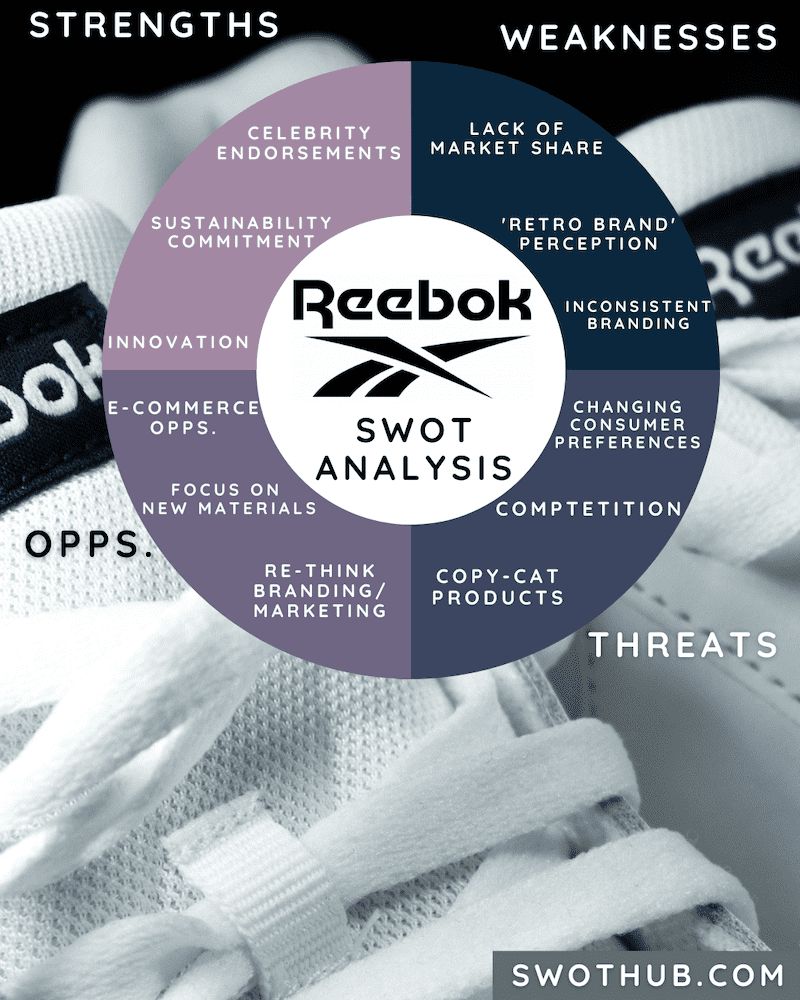
Reebok SWOT Analysis Opportunities:
Reebok has multiple options to regain market share after its competitors such as Adidas and Nike have taken much of it. The following portion of the Reebok SWOT analysis will examine some of Reebok’s opportunities compared to competitors include:
Innovation of materials and design: Reebok has a history of innovating new technologies and materials to boost the functionality of its footwear and apparel. Reebok can create innovative new products that set them apart from its rivals by continuing to make research and development investments.
Sustainability: In a Reebok SWOT analysis, Reebok has committed to sustainability and has carried out a number of projects to lessen its impact on the environment. By providing environmentally friendly products, Reebok can stand out as consumers become more environmentally conscious.
Increase high-level partnerships: Reebok has a history of working with prominent athletes and celebrities, which aids in boosting brand recognition and promoting its goods to a larger audience. Reebok can broaden its appeal to customers by partnering with powerful figures in sports and entertainment in the future.
International expansion: Reebok has a sizable market share in North America but little elsewhere in the world. Reebok can tap into new markets and increase its customer base by broadening its global reach.
E-commerce opportunities: The growth of e-commerce presents an opportunity for Reebok to reach more customers and sell its products directly to consumers. By investing in its online presence and offering a seamless shopping experience, Reebok can attract more customers and increase its sales.
Reebok SWOT Analysis Threats:
Threats pose a risk to every company’s stability and profitability. In a SWOT analysis of Reebok, some of its largest threats compared to competitors include:
Intense competition: The sportswear industry is extremely competitive, with both well-known companies like Nike and Adidas and newer brands. Because of this, it might be challenging for Reebok to differentiate itself and win market share.
Economic conditions: Reebok’s sales are subject to economic fluctuations because, in uncertain economic times, consumers might be less inclined to spend money on non-essential items like athletic footwear and apparel.
Changing consumer preferences: Consumer preferences and trends can change rapidly, and Reebok needs to stay ahead of these changes to remain relevant. If Reebok is unable to adapt to changing consumer preferences, it risks losing market share.
Counterfeit products: Counterfeit products can undermine Reebok’s brand and reputation, as consumers may unknowingly purchase inferior products that are marketed as Reebok products.
Supply chain disruptions: Reebok’s business is dependent on its supply chain, and disruptions to this chain (such as natural disasters or geopolitical instability) can impact its ability to produce and sell its products.
Brand perception: Negative publicity, like scandals or product recalls, can have an impact on how people view the Reebok brand. This could harm the reputation of the company and make it more challenging for Reebok to draw in and keep customers. An unfavorable impression may be formed by Reebok’s ability to recover from years of market share losses.
Reebok’s Competitors:
In a SWOT analysis of Reebok, its competitors would fall under the “threats” category. Here are some of Reebok’s main competitors in the sports apparel industry. Many people ask:
Does anyone still wear Reebok?
Reebok does still have a following but it has become smaller over recent decades because of these Reebok competitors:
- Nike: With a strong emphasis on innovation, design, and marketing, Nike is one of the largest producers of athletic footwear and apparel worldwide.
- Adidas: One of the biggest sportswear manufacturers in the world is Adidas, a multinational corporation based in Germany. Adidas is renowned for its potent brand, ground-breaking goods, and associations with prominent sports figures and celebrities.
- Puma: Puma is a German multinational company that creates and produces athletic and everyday clothing and footwear. Puma is renowned for its distinct branding, cutting-edge merchandise, and partnerships with prominent athletes and celebrities.
- Under Armour: The sportswear brand Under Armour is based in the United States and produces athletic clothing, accessories, and footwear. The innovative products and performance-oriented approach of Under Armour are well known.
- ASICS: ASICS is a Japanese multinational corporation that designs and manufactures athletic footwear and apparel. ASICS is known for its focus on quality, comfort, and performance, particularly in the running and training categories.
These companies compete with Reebok across a range of categories, including running, training, lifestyle, and sports-specific products.
Reebok SWOT Analysis – Conclusion and Recommendations:
Reebok needs to focus on a number of key strategies to remain competitive in the athletic sportswear industry.
To continue to stay relevant against competitors, Reebok should consider the following recommendations:
- Invest in innovation: To differentiate its products from those of rivals, Reebok should continue to make investments in research and development for the development of new technologies, materials, and designs.
- Create more sustainability initiatives: Reebok should continue to prioritize sustainability and create products that utilize recycled materials, cut down on waste, and have a smaller impact on the environment. This may draw environmentally conscious customers.
- Expand product range: To appeal to a wider range of customers, including those who are searching for a wider variety of products outside of athletic footwear and apparel, Reebok should think about expanding its product line.
- Strengthen partnerships: Reebok should continue to partner with high-profile athletes and celebrities to increase brand awareness and promote its products to a wider audience.
- Improve e-commerce: To give customers a simple and convenient shopping experience, Reebok needs to enhance its e-commerce platform. This includes making sure that the website is simple to use, improving mobile compatibility, and providing free shipping and returns.
- Focus on brand perception: Reebok should focus on improving its brand perception by addressing any negative publicity, developing a consistent and clear brand image, and ensuring that its products meet customer expectations.
- Expand globally: Reebok should expand its global reach and enter new markets to tap into new customer bases and grow its sales. This includes targeting emerging markets, such as Asia and Latin America, where there is a growing demand for athletic footwear and apparel.
Reebok should look back to its history to re-discover what made them successful in the earlier years. Focusing on the female, aer0bic-centric demographic made them iconic back in the 1980s and 90s. Through this Reebok SWOT analysis, they should look at their competitors’ strengths and minimize their weaknesses to regain a larger percentage of the sportswear market.

